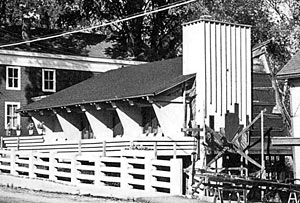February/March 2011
By Brad Emerson
Why did Blue Hill Pavilion, Maine’s most exciting structure of 1946, last just a dozen years before it was deemed “too New York” and demolished? ’Twas provincial taste that killed the beast.
 For the first half of the 20th century, the advance of modern art and architecture was viewed with alarm and suspicion by many. Blue Hill was no exception. Oh, there’d been flirtations with modernism in the village of mostly white clapboards and gray shingles, but not so much as to threaten public safety. In 1911, a Chicago bottled-water tycoon erected a small, Prairie-style summer house–modern, but not so radical as to disturb the populace unduly. In 1938, an artistic heiress risked an International-Style villa on the shore east of town, but life went on. In 1946, Walter Gropius and The Architect’s Collaborative (TAC) designed a gull-wing-roof house in nearby Brooklin, which caused slight sputtering (‘looks like a school!’). Little did the good people of the region suspect that the modern movement was about to strike Blue Hill with hurricane force: Lynn Thompson and Dorothy Chester Heywood, both born in the 19th century, had arrived in town.
For the first half of the 20th century, the advance of modern art and architecture was viewed with alarm and suspicion by many. Blue Hill was no exception. Oh, there’d been flirtations with modernism in the village of mostly white clapboards and gray shingles, but not so much as to threaten public safety. In 1911, a Chicago bottled-water tycoon erected a small, Prairie-style summer house–modern, but not so radical as to disturb the populace unduly. In 1938, an artistic heiress risked an International-Style villa on the shore east of town, but life went on. In 1946, Walter Gropius and The Architect’s Collaborative (TAC) designed a gull-wing-roof house in nearby Brooklin, which caused slight sputtering (‘looks like a school!’). Little did the good people of the region suspect that the modern movement was about to strike Blue Hill with hurricane force: Lynn Thompson and Dorothy Chester Heywood, both born in the 19th century, had arrived in town.
An artist and writer, Thompson was the mother of architect Benjamin Thompson, who was working on the Brooklin project with TAC. Thus introduced to the area, she and partner Dee Heywood bought a large old summer house at a low postwar price, and in the time-honored tradition of architects’ mothers everywhere, Thompson commissioned her son to give the French Provincial house a makeover. Out went the curved staircase, in went risers suspended by rods from the ceiling. Out went the French doors, replaced by a wall of glass. “That lovely old house!” cried the people. Thompson and Heywood were only warming up.
Thompson is remembered as kind and generous, and in the opinion of her daughter-in-law, Jane Thompson, typified the “pioneer, get it done” spirit that prevailed after the war. Heywood was quieter and more methodical but no less visionary in outlook. They threw themselves into the cultural life of the community.
Thompson assembled a collection of fifty works of avant-garde art, including Rothko, Pollock, Motherwell, Klee, Picasso, and Rouault, purchased in New York though the Betty Parsons and Downtown Galleries. She offered to exhibit her collection at the local library as a fundraiser. Fearful that modern art alone was not a sufficient draw, she offered blueberry pie as the refreshment, calling the exhibit “Picasso & Pie.” Thompson made it known in the local newspapers that she would personally bake a pie and air-freight it to Picasso in France, that he might participate from afar in the opening (history does not record his reaction). The exhibit was a runaway success, and Thompson and Heywood were emboldened to begin a new, bigger adventure.
In 1948, Heywood invested in Adelaide Pearson’s Rowantrees Pottery in Blue Hill. Heywood wanted to diversify the business, founded during the Depression to boost the local economy, by adding a weaving line. She opened a Rowantrees showroom in Manhattan, probably designed by Ben Thompson. In Blue Hill, they purchased the 1842 Stevens building, to which they added a radically modern wing called the Pavilion.
It is not known why Thompson did not use her son for the design–although surely he had input–but rather called upon Eaton Tarbell Associates of Bangor. Tarbell assigned the product to chief designer Cooper Milliken, who’d recently graduated from Massachusetts Institute of Technology. With bold patrons who had a generous budget and wanted something outside the box, Milliken, a quiet intellectual, produced a sleek, handcrafted design with clear nods to Frank Lloyd Wright’s Taliesin West and Rudolph Schindler’s Rodriguez house in Los Angeles. Tempered by traditional Maine materials and scale and with its skewed side elevations and the front cantilevered over the millstream, the building arrived just in time for the mid-century. It was the first new commercial building erected in the village’s commercial district since the late 1800s, and its progressive design caused uproar. Sheila Varnum of Rowantrees remembers that many felt the project was just “too New York.”
Inside, natural materials and sloping walls combined with exposed joinery to create drama. Glass walls captured light and views of the nearby harbor. It was a stunning building, one of the most daring of its era in Maine. The opening was attended by Robert Motherwell and Betty Parsons. Unfortunately, the Rowantrees joint venture did not succeed, the New York showroom was shuttered, and the business was recast as The Blue Hill Pavilion. Although Thompson claimed never to hold a mixing spoon until after she was fifty, she and Heywood opened a full restaurant. In attempts to increase cash flow, they offered the option of mail-ordering their cakes and pies. Local weaving continued to be featured, and for the first time in the area, French cheeses were available, a fact that did not go unnoticed in a New York Times article. Art exhibits, which had first been mostly on consignment from the Metropolitan Gallery in New York, shifted to local under the direction of Francis Hamabe, hired in 1951 as art director.
In 1955, when Ben Thompson founded Design Research–the first retail store devoted to modern furnishings–his mother, ever a step ahead, had a member of his office staff making runs via station wagon to Blue Hill bearing DR inventory to sell at the Pavilion. By the next season, the Pavilion was advertising Danish pottery, Noguchi lamps, and Jens Risom furniture, making it the unofficial first outpost of the store that brought modern design to America.
By the 1960s, despite critical and popular acclaim, the Pavilion continued to be a financial and physical drain, and Lynn Thompson, now seventy, moved to Cambridge. The Pavilion was leased and became a tearoom and gift shop until it was finally shuttered two years later. In 1964, Thompson wrote a slim cookbook-memoir of the venture, titled Picasso and Pie, which remains a cult classic. Ironically, the building would stand only three more years, demolished in 1967 by its new owner, an insurance agent whose tastes ran to something more traditional. One of Maine’s gutsiest adventures into the new lasted barely a dozen years. n
Brad Emerson is an antiques dealer and writer living in Blue Hill. Follow his blog on local architecture at thedowneastdilettante.blogspot.com.





0 Comments
Trackbacks/Pingbacks